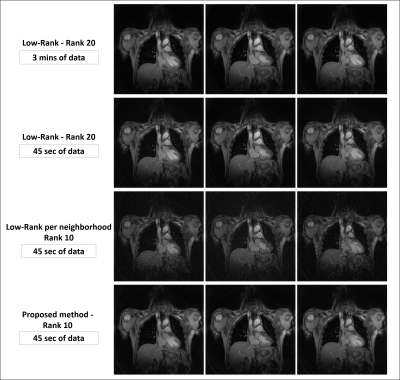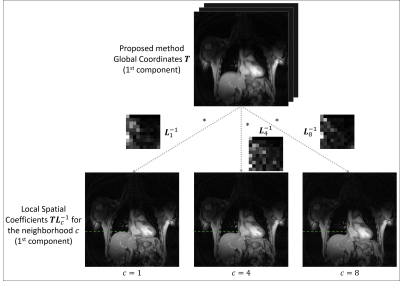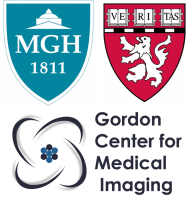Yanis Djebra1,2, Isabelle Bloch2,3, Georges El Fakhri1, and Chao Ma1
1Gordon Center for Medical Imaging, Department of Radiology, Massachusetts General Hospital, Harvard Medical School, Boston, MA, United States, 2LTCI, Telecom Paris, Institut Polytechnique de Paris, Paris, France, 3LIP6, Sorbonne University, CNRS, Paris, France
1Gordon Center for Medical Imaging, Department of Radiology, Massachusetts General Hospital, Harvard Medical School, Boston, MA, United States, 2LTCI, Telecom Paris, Institut Polytechnique de Paris, Paris, France, 3LIP6, Sorbonne University, CNRS, Paris, France
We present a new approach to
manifold learning-based image reconstruction for
dynamic MR that can be seen as a generalized low-rank matrix/tensor model. The geometries of the manifold are learned locally and images are reconstructed globally, aligning the tangent spaces in each neighborhood.

Figure 3: Comparison
of the proposed method with Low-Rank (LR) reconstructions. The first row shows
representative images obtained by the LR reconstruction with rank 20 using k-space
data of 3-min acquisition (reference). The rows 2 to 4 show reconstructions
using only 45 sec of data. The 2nd row shows images reconstructed using
a global LR model of rank 20. The 3rd row shows images obtained by
performing a rank-10 local LR reconstruction (i.e. at each neighborhood). The 4th
row shows the images using the proposed method where the dimension of each
tangent space is 10.

Figure 2: Global
coordinates (spatial coefficients) and affine transform matrices of the
proposed method. The 10×10 affine transform matrix $$${L}_c^{-1}$$$ is represented using grey levels. The 1st component of $$$T$$$ is a temporal average of all the
neighborhoods. Our proposed model successfully describes the local coordinates
by applying an affine transform $$${L}_c^{-1}$$$ to the global coordinates $$$T$$$ at each neighborhood $$$c$$$. The green dashed lines
indicate the position of the liver for the 1st component of the 1st
neighborhood.
